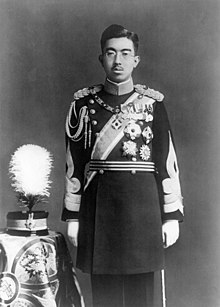
Back Hirohito Afrikaans ሂሮሂቶ Amharic Hirohito AN हिरोहितो, जापान के सम्राट ANP هيروهيتو Arabic هيروهيطو ARY هيروهيتو ARZ Hirohito AST हिरोहितो AWA Hirohito Azerbaijani
| |||||||||
|---|---|---|---|---|---|---|---|---|---|
 Formal portrait, 1935 | |||||||||
| Emperor of Japan | |||||||||
| Reign | 25 December 1926 – 7 January 1989 | ||||||||
| Enthronement | 10 November 1928 | ||||||||
| Predecessor | Taishō | ||||||||
| Successor | Akihito | ||||||||
| Sesshō of Japan | |||||||||
| Regency | 25 November 1921 – 25 December 1926 | ||||||||
| Monarch | Taishō | ||||||||
| Born | Hirohito, Prince Michi (迪宮裕仁親王) 29 April 1901 Tōgū Palace, Aoyama, Tokyo, Japan | ||||||||
| Died | 7 January 1989 (aged 87) Fukiage Palace, Tokyo, Japan | ||||||||
| Burial | 24 February 1989 | ||||||||
| Spouse | |||||||||
| Issue | |||||||||
| |||||||||
| House | Imperial House of Japan | ||||||||
| Father | Emperor Taishō | ||||||||
| Mother | Sadako Kujō | ||||||||
| Religion | Shinto | ||||||||
| Signature | |||||||||
Hirohito[a] (29 April 1901 – 7 January 1989), posthumously honored as Emperor Shōwa,[b] was the 124th emperor of Japan according to the traditional order of succession, reigning from 1926 until his death in 1989. He was the longest-reigning Japanese emperor and one of the world's longest-reigning monarchs, reigning for 62 years during the Shōwa era, which saw Japan's militarization and imperial expansion in Asia, involvement in the Second Sino-Japanese War and World War II, and economic recovery and boom.
Hirohito was the first child of Crown Prince Yoshihito and Crown Princess Sadako (later Emperor Taishō and Empress Teimei). After his father's accession to the throne in 1912, Hirohito was proclaimed crown prince and heir apparent in 1916. In 1921, he made an official visit to Great Britain and Western Europe, the first overseas visit by a member of the Japanese royal family. Owing to his father's ill health, Hirohito became regent in 1921. In 1924, he married Princess Nagako Kuni, with whom he had seven children.
Hirohito became emperor upon his father's death in 1926, serving as head of state during the 1930s as the military increasingly dominated Japanese politics. When Japan's Kwantung Army staged the Mukden incident as a pretext for its invasion of Manchuria in 1931, he made no objection. Following the onset of the Second Sino-Japanese War in 1937, tensions steadily grew between Japan and the United States, and on 1 December 1941, Hirohito formally sanctioned the government's decision to go to war against the U.S. and its allies. One week later, the Pacific War began with Japan's attack on Pearl Harbor and U.S. and British colonies in Southeast Asia. Once the war had turned decisively against Japan, Hirohito called upon his forces to surrender in a radio broadcast on 15 August 1945. To this day, the extent of his involvement in military decision-making and his wartime culpability remain subjects of historical debate.
Following Japan's surrender, Emperor Hirohito was not prosecuted for war crimes at the Tokyo War Crimes Tribunal even though the Japanese had waged war in his name. Douglas MacArthur believed that a cooperative emperor would facilitate a peaceful occupation of Japan and support U.S. postwar objectives, thereby leading him to exclude any evidence that could have incriminated Hirohito and his family.[1] Upon being pressured by the Allies into renouncing his divinity in 1946, Hirohito became "the symbol of the State and of the unity of the people" under the nation's new constitution. In this role, he took on a more prominent public presence and oversaw Japan's reintegration into the international community. Hirohito died in 1989 and was succeeded as emperor by his eldest son, Akihito. At the time of his death, he was the world's only monarch with the title "Emperor".
Cite error: There are <ref group=lower-alpha> tags or {{efn}} templates on this page, but the references will not show without a {{reflist|group=lower-alpha}} template or {{notelist}} template (see the help page).